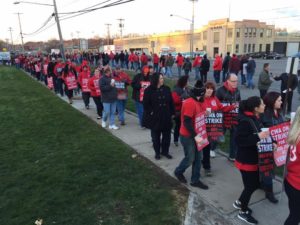The strike of journalists, photographers, and editors at the Halifax Chronicle Herald, Canada’s oldest independent newspaper, has passed the 100-day mark with no end in sight. During the strike, the newspaper has hired freelance strikebreakers whose unbylined stories have compromised the paper’s reputation with questionable reporting and a lack of editorial oversight. The paper has even resorted to presenting paid advertorials as fact-based stories.
The Halifax Chronicle workers, who first organized Halifax Typographical Union (HTU) in 1999, saw a round of layoffs and early retirements in 2009, which left 60 people to do the work of 100. Now, HTU was asking remaining workers to accept a contract that would see overtime pay start at 48 hours.
Meanwhile, the striking Halifax workers have channeled their skills onto HTU’s online news site, Local Xpress. This spring the site announced it was now a complete, online, nonprofit newspaper. Though they are not yet receiving wages beyond strike pay, the site is giving the workers an expanded online presence.





